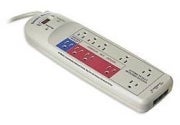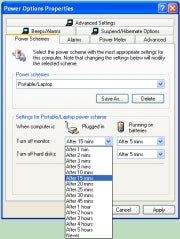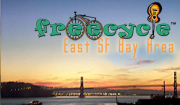With Earth Day approaching, you're probably thinking about the different ways you can do your bit for the environment. Well, if you're reading this, it's a pretty safe bet you're using a computer, and computers generate waste in all kinds of ways. But by changing just a few habits, you can keep more stuff out of landfills, save energy, and even tuck a few extra dollars in your wallet. Here are five ideas to get you started.
1. Save Paper and Ink
I receive a lot of press releases and other printed documents that I never read more than once (if ever), so when I can get away with it I print on the reverse side of these pieces, reserving my pristine sheets for letters and other important documents. The savings are tangible: I've bought exactly one 500-sheet pack of paper in the last two years.
You can save more paper by shrinking your text and printing two pages side by side on one sheet of paper, if your printer driver allows it. (You'd better have good eyesight, though.) In Windows XP, choose Print, and then select Preferences or Print Setup. Look for an option called 'Pages per Sheet', and set it to 2.
If you print a lot from the Web, you should absolutely download a copy of the ad-supported Green Pink World so that you can trim the stuff you don't need printed, which saves both paper and ink (or toner).
You can also save ink--easily the most expensive part of any inkjet printer--by printing in draft mode whenever possible. Look for more tips in "The Cheapskate's Guide to Printing."
2. Stop Wasting CDs and DVDs
I can't count the number of times someone has burned a disc just to give me, say, 100MB of data, leaving the remaining 600MB (or, worse, 4GB or more) unused. Rewritable discs cost more and take a little longer to burn, but they're perfect for passing data back and forth without throwing out all that metal and plastic.

When you're done with your discs, you can recycle them by sending them to Green Disk for responsible destruction and reuse. You must pay a small fee--$6.95 for boxes 20 pounds or lighter--but you can also cram in any other electronic waste you have lying around. Though GreenDisk guarantees that the material on your discs won't fall into the wrong hands, the extracautious can protect their data beforehand using Aleratec's . CD/DVD Shredder Despite its name, the CD/DVD Shredder actually pounds thousands of tiny pits into the surface of a disc, rendering it unreadable. Aleratec doesn't sell it anymore, but it does turn up on Amazon and eBay.
3. Tweak Your Power Settings
If you're like me, your computer is on all day, but you don't work on it continuously. Turning it on and off isn't an option, but a quick trip to the Windows Power Options control panel can shave your usage down a bit. There, you can set your monitor and hard drives to power down when you haven't been using the PC for a while. It takes only a second for them to power up again, so you can use that time to get comfortable in your chair.
Most important, you can set the computer itself to go to sleep or to hibernate after a certain period of inactivity. Sleep mode is a low-power mode, and as with the hard disks and monitor, it has everything up and running in just a few moments when you want to start working again. Hibernation, in contrast, switches the computer off but saves your current work environment first. As you'd expect, waking the computer up from hibernation takes a bit longer.
Tip: Windows XP SP2 sometimes has a problem making hibernation work when your PC has more than 1GB of RAM--oddly, it generates an error message saying that you don't have enough resources. A quick visit to Microsoft Knowledge base Provides a Patch that fixes it right up.
By the way, these tips also apply to your portable devices. MP3 players, cell phones, PDAs, and handheld game machines have settings for powering down or adjusting their screens, Bluetooth, or Wi-Fi settings. Switching off what you don't need (or even just turning down the screen brightness) extends battery life, which means less recharging.
4. Turn It Off!
Printers, scanners, speakers, monitors--surrounding your computer is a multitude of peripherals that will happily keep on sucking power even when the PC is switched off. It doesn't seem like much, but even an idle printer is a drain on your utility bill. The simple rule of thumb is to turn anything off when you're not using it. That includes turning off your monitor (rather than letting it sit in low-power mode when the computer is off), and turning on your printer only when you actually have something to print.

The trouble is that some devices have hard-to-reach power buttons--or worse, no power buttons at all. Power strips such as the Smart Strip can help; the Smart Strip, for example, switches off devices plugged into specific outlets when the computer is switched off.
Also, don't forget to unplug your phone, camera, or any other rechargeable device as soon as it's finished juicing up--even though the batteries are smart enough to stop drawing power when they're full, electricity is still flowing through the cable. Some Nokia phones will even nag you to unplug them when they're done.
5. Find a New Home for Your Old Tech
So you're getting ready to upgrade to a new computer, but you've discovered that you have no room in the closet for the old one because it's already filled with a decade's worth of obsolete technology. What to do? One solution is to recycle your old gadgets by bringing them somewhere where they'll be disposed of properly. You can find a list of services in your area by checking out Earth 911's Web site, which tells you where to dispose of everything from batteries to toner cartridges to the 386 you've had knocking around since the first George Bush was in office.
Better still, you can Freecycle your old equipment. Freecycle is a network of local mailing lists (there are over 4000 globally, from Andorra to the Virgin Islands) for people who want to give stuff away or are looking for free stuff. Just post a message about what you want to give, and someone will probably offer to take it off your hands--and isn't finding your old computer a new home better than just having it dismantled?
Whichever method you choose, don't forget to wipe your hard drive clean first. Use a utility such as File Shredder to delete any sensitive data from your hard disk before it slips out the door.




 among others.
among others. slide attribute, a black casing and a 2.8 inch screen. It also has a kickstand on its back cover for a convenient hands-free viewing. It weighs around 125 grams and has vitals of 103 mm x 55 mm x 18 mm. This would be for its height, width and thickness respectively.
slide attribute, a black casing and a 2.8 inch screen. It also has a kickstand on its back cover for a convenient hands-free viewing. It weighs around 125 grams and has vitals of 103 mm x 55 mm x 18 mm. This would be for its height, width and thickness respectively.

 My StumbleUpon Page
My StumbleUpon Page




